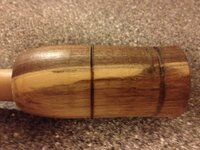You are using an out of date browser. It may not display this or other websites correctly.
You should upgrade or use an alternative browser.
You should upgrade or use an alternative browser.
Please help the new guy!
- Thread starter NittanyLion
- Start date
Signed-In Members Don't See This Ad
Signed-In Members Don't See This Ad
plantman
Member
Heartwood and sapwood. Jim S
NittanyLion
Member
Thanks Jim!
Dick Mahany
Member
Agree wih Plantman. Burl would have "eyes" or wildly varying grain, spalt would have well defined thin black veins, I'd make a pen out of it anyway and be happy. Often the transitio fro heartwood to sapwood makes for some interesting patterns.
robutacion
Member
Hi everyone.....new to turning.....can someone help me with what this is exactly. It's from an old walnut log I was playing with on the lathe. Is it just the transition from sapwood to heartwood or is it burled or spalted? Appreciate any advice!
Yes, a bit of sapwood (yellow) among the heartwood, these pieces with the 2 colours are also known as "2 tone", something that is always attractive to see on any finished pieces, big or small, there is, in my opinion, other people would think otherwise...!
One other sign of spalted woods is that, 99.5% of them are light in weight, there is from the decomposition stages that can be minor or major, being "dust" the unworkable stage, anything above that, is workable but will need hardening/stabilization or other.
I may leave a description of "Burl" for some other time but, and as a point of interest, most of the more exquisite colourations and grains are found in many spalted wood species (not all spalt but they all rot/decompose), spalting is an interesting phenomenon that is created by nature and its creatures, I have made a small video some time ago, showing these microscopic creatures (some big enough to be seen with a naked eye) and give a good idea of some of the steps of the spalting process and those creatures adapted for such task, here...!
Cheers
George

